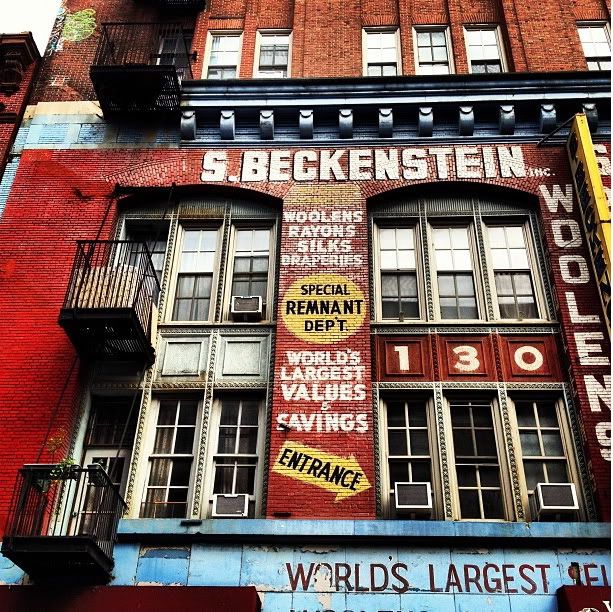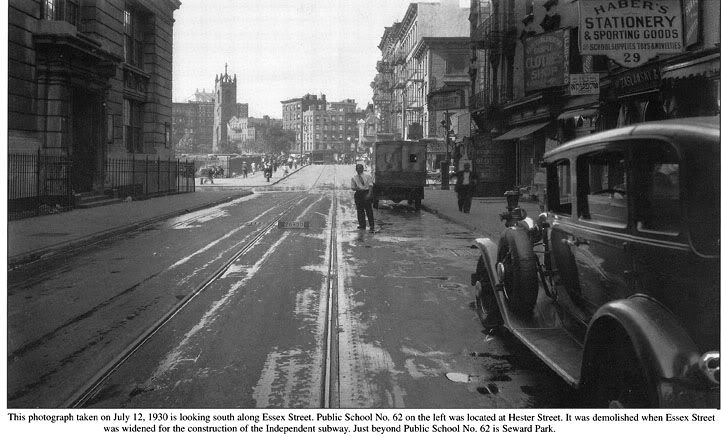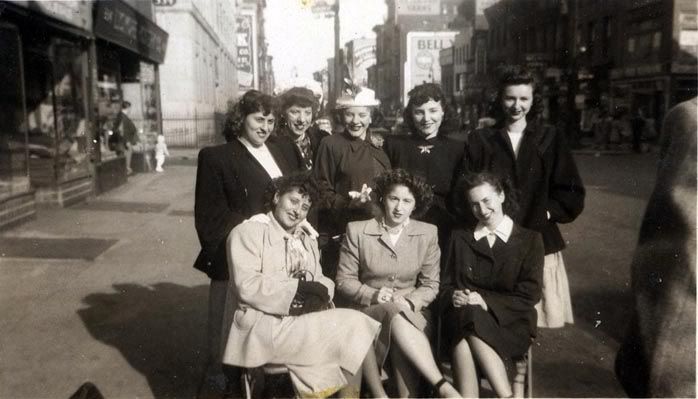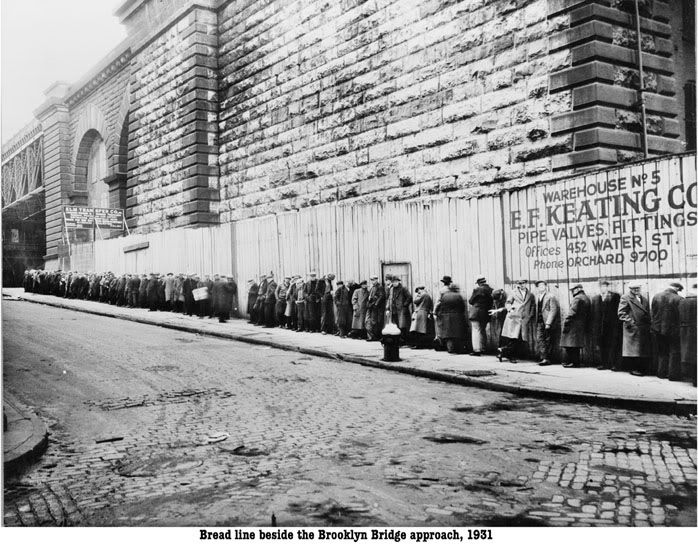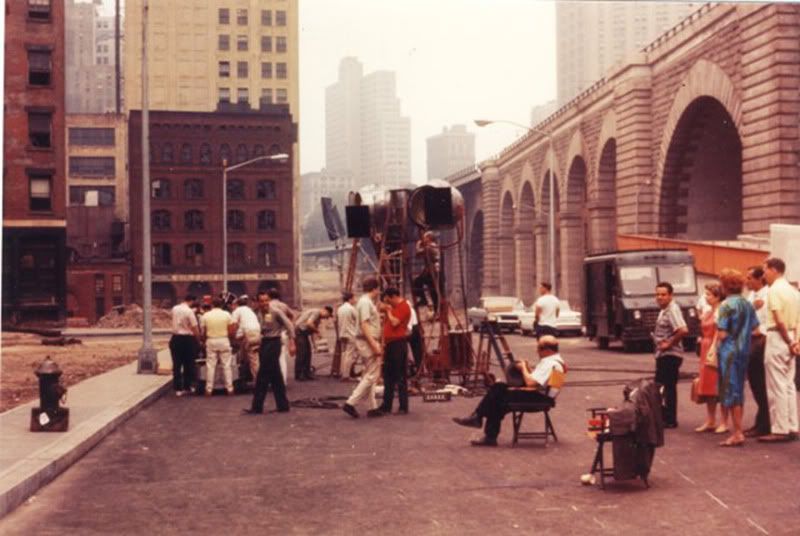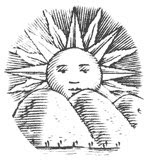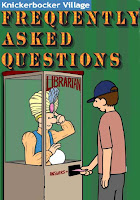Friday, April 27, 2012
Sam You Made The Pants Too Long
Pants are draggin', slowly draggin' through the street
See, I'm walking, you can hardly see my feet
I'm not finding fault at all
They're so big, I'm too small
You made my coat and vest fits the best
You made my lining good and strong
But Sam, Sam the pants.. too long
You made my pink lapel fits me so swell
Say who am to say you're wrong?
Sam, you made pants too long
I got a belt, I got suspenders
I figure, what I got lose?
What goods the belts, what goods suspenders
When the pants hang over shoes?
I get the darndest little breeze right through my BVD's
My fly is where my tie belongs
Sam, Sam, Sam,
The pants, the pants
Labels:
Beckenstein's,
milton berle,
Orchard Street,
red buttons
130 Orchard Street: Beckenstein's
The long time business is no longer located here. I believe it's previous life was as a branch of the NY Electric and Gas Company.
an excerpt from fabricczar
Armed with a push cart and insurmountable determination, Samuel Beckenstein laid the groundwork in 1919, on the Lower East Side's historic Orchard Street for what would ultimately develop into one of the world's most renowned fabric enterprises, Beckenstein Men's Fabric, Inc. Nearly a century and four generations later, Beckenstein's grandsons, Neal Boyarsky, President and CEO of the firm and his son Jonathan, have expanded and transformed the once modest, one room store, into an unstoppable fabric enterprise, servicing the entertainment industry, celebrities, athletes and government officials worldwide. The company's success is not only attributed to the family's unwavering commitment to the fabric industry, but it is also due to their exclusive, joint partnership with Scabel of Brussels, one of the world's most distinguished fashion leaders, who manufacture the finest and most high end fabrics. In addition to the incomparable quality and endless variety of fabric that Beckenstein Men's Fabric, Inc. offers, the company also provides their customers with unrivaled service, delivering stock fabric overnight.Supposedly the song, "Sam, You Made The Pants Too Long," was written with Sam Beckenstein in mind By some accounts it was written by Milton Berle, Sam Lewis, Victor Young, Fred Whitehouse
SAM, YOU MADE THE PANTS TOO LONG was written in 1940 by comedian Milton Berle as a parody of the tune "Lord, You Made The Night Too Long." It appealed to Barbra Streisand`s sense of humor and it became her follow-up hit to "Second Hand Rose" in 1966.
Wednesday, April 25, 2012
29 Essex Street: Haber's Stationery and Sporting Goods
Viewable on the right side. It was a favorite destination of KVers. Supposedly, Joe Kuperstein once considered becoming an owner. about two years ago from Marsha Algranati Levine:
I lived on Essex St, over Haber's. My mom actually worked in Habers, a pretty short commute. My parents moved into the Seward coop my last year in high school, my mom's still living there. If anyone hasn't been in the old neighborhood for a while, you're in for a big shock, it's changed a lot.
341 Grand Street: Site Of Grand Street Dairy Restaurant
The photo was taken sometime in the late 1940's. The view is Grand Street looking east towards Ludlow Street. The Dairy Restaurant (although I don't know that was it's incarnation at the time) can be seen at the extreme right. My mother is in the top row on the left. My aunt is seated in the middle. For more about that restaurant, an excerpt from a 1988 nytimes article
2 Waiters and Their Producer Dine at a Source of Inspiration By RICHARD F. SHEPARD Published: November 10, 1988 ''Enter, two Jewish waiters.'' Now what kind of stage direction is that in a script for the New York Shakespeare Festival? It may have been that Joseph Papp, the founder and head of the festival, was evading an answer. But more likely, he never heard the question above the gustatory din at the Grand Dairy Restaurant, Grand Street at the corner of Ludlow Street, on the Lower East Side. Mr. Papp was accompanied by Bob Dishy and Fyvush Finkel, who nowadays are bringing an inspirational interpretation of tray chic to their central roles as Jewish waiters in Hy Kraft's ''Cafe Crown,'' a play based on the old Cafe Royal, which for decades was the center of the Yiddish theater's off-duty life on Second Avenue. The play is being produced by Mr. Papp and his festival at the Public Theater. Frank Rich, reviewing ''Cafe Crown'' in The New York Times, called it a ''feast of Jewish waiter jokes and Jewish theater jokes, heavily laced with schmaltz.'' He particularly praised the waiters - Mr. Dishy, ''his expression so dill-sour that even his tufts of hair seem exasperated,'' and Mr. Finkel, ''sure to say 'You'll love it!' to any irritating customer who alights upon one of the less palatable daily specials.'' In Other Words, an Interview The lunch on Grand Street was intended to install the professional theater people in suitable ambiance amid real Jewish waiters for the purpose of discussing how the actors achieved a credibility so overpowering in their roles as waiters that the audience might have picked up a check were it presented. Mr. Dishy and Mr. Finkel, projecting a thinly veiled contempt for their customers, evoke a world now hovering on the brink of oblivion. Wearing black jackets, black bow ties and full-length white aprons, they display tympanic virtuosity when it comes to slamming plates on the table. They intimidate diners, kibitz at card games, dish out philosophy and invariably spill half the tea from the glass. The Shakespeare Festival is meticulous about training its performers in swordplay, with an expert on hand to teach the finer points of the epee. Did Mr. Papp hire a Jewish waiter to instruct Mr. Dishy and Mr. Finkel in their roles? Did he show them how not to meet the eye of a complaining customer, how to put the thumb in the soup to indicate that it is not too hot to slurp, how to bring the potato pirogi to a table that wanted chopped liver? Did a licensed instructor teach them the shuffle that assures room temperature by the time a hot dish reaches the table? Necessary but Insufficient The answer again proved elusive. After all, every waiter who happens to be Jewish is not necessarily qualified as a Jewish waiter....some KVers' comments:
I walked by there yesterday with my wife and told her about the restaurant. Most embarrassing was cutting class and seeing your teacher there.
I remember the dairy restaurant very well from my Seward days. Used to take out a cheese danish and coffee every so often when I stayed late to edit the sports column of the Seward World. Those were the days....
Tuesday, April 24, 2012
Guss' Pickles
an excerpt from a nytimes' article on Guss'
The author is related to Marilyn Altman and Goldie Daniels, the Guss girls, who are heard above.
The author is related to Marilyn Altman and Goldie Daniels, the Guss girls, who are heard above.
I know it’s unseemly to brag about one’s illustrious family lines, but sometimes a historic turn of events invites the opportunity to name-drop. Some of my closest friends don’t even know it, but I’m related to Jewish royalty (by marriage, I should clarify, but still). My brother married into pickles — Guss’ Pickles, to be specific, the famous Lower East Side institution that announced this week that it would soon leave that neighborhood for the lower rents and enthusiastic pickle purchasers of Borough Park, Brooklyn. The New York blogs have been outdoing themselves in fits of nostalgia about this loss of lingering history on Orchard Street. But for my brother’s mother-in-law, Marilyn Altman, and her sister, Goldie Daniels — the Guss girls, as they were known back in the day, along with their late sister, Elaine — the news about the business, which they sold in 1979, came as a shock. It was also an excuse for them to come in from New Jersey, where they both live, share some old stories about their father, Isadore Guss, and, in Goldie’s case, wolf down some of the half-sours she loves so well. After greeting the current owner of the shop, Goldie, blond and petite at 71, in a gold watch and gold hoops, instinctively situated herself in back of the barrels, the vantage point from which she had sold so many pickles to long lines down Hester Street, the store’s original location. “I ate more pickles than I sold,” she said, dipping a pan — a schissel, she called it, Yiddish for pail — into a barrel. “I loooove pickles.” She took a bite and rolled her eyes. “It’s like my heritage.” Of the three daughters, only Marilyn, the baby, now 65, was deprived the privilege of working at the store. That’s what you get for dropping a yo-yo in a pickle barrel and thinking maybe no one would notice. Goldie, however, worked there until she had children. If her mother had thought a woman could run a business, Goldie would have taken it over after her father’s death in 1975. Those days holding court behind the barrels as the whole neighborhood stopped by were some of the happiest of her life. “You just talked to everyone,” she said, and it was easy to see how that worked. As she chewed her pickle, a man with his daughter contemplated the barrels, and suddenly they were all four in animated conversation about the Great Wall of China, from where the father and daughter had just returned. What did they think? Wasn’t it fabulous? When Marilyn went, she’d worn the wrong shoes, wouldn’t you know it, kept sliding backward the whole time.
A View Of Gluckstern's In 1947
A blow up from a still shot taken during the filming of Naked City. Gluckstern's is visible (blurry) in the top right corner.
Gluckstern's: 135 Delancey Street
Gluckstern's Restaurant was a Jewish or Yiddish restaurant that started in NYC in the early 1900s. This restaurant with its home cooked style meals (Romanian, Hungarian, Slavic and Corned Beef and Cabbage "Kosher" Style) was popular with a lot of the stars of the era as well as having a loyal following with the general public. I have a nice 1959 write up on the restaurant and I found mention of the restaurant in some 1960s era publications but I don't find any info after that point, so it looks like this restaurant was around over 60 years and then must have closed. I checked the 135 Delancey St Address in a current search and it seems to be a parking garage or lot.The Fabulous Kuperstein twins had their bar mitzvah at Gluckstern's
Monday, April 23, 2012
101 Orchard Street: 1934
This could be near where former KVer Norma A. Petillo's (Boodman) father had a store.
She wrote:
Sadly, my father died in 1951 at age 44. He owned a small store on Orchard Street, mens' belts, ties socks etc. It was really a stand so he was mostly exposed to the elements, not good for a person with a heart condition. His name was Frank Boodman. He was born in the US but his family went back to Poland. I did locate him and his brothers Dawid (David) and Phillip on the Ellis Island web site when they were young teens who came back to the states. I found my mother, Clara, there as well. She was born here, family from Austria, but they went back to Poland. She and her brother, Morris Holzer (spelled here with a t) came back separately to the states at ages 14 & 15. Sadly, my 4 aunts and grandmother and some cousins were killed in Poland in 1943. All the more tragic because there were already here, but had left a child back there , and were poor and could not make a go of it in the U.S.
Sunday, April 22, 2012
There Used To Be A Bakery Here: Gertels
A video I put together back in 2007, just prior to Gertels' closing. It was on 53 Hester Street. Kadouri Import was at 51 Hester and a tile factory was at 55. Many of the images came from this nytimes article :
An excerpt:
No More Babka? There Goes the Neighborhood By JOSEPH BERGERAnother story about the closing from lost new york city
Gertel’s, the legendary bakery on Hester Street on the Lower East Side known for its Jewish treats like rugelach, babka and marble cake, has closed its doors. The closing is one more change in a string of changes on the historic Lower East Side, where hundreds of thousands of immigrants from Russia, Poland, Romania and Italy established their foothold in America and set up hundreds of dry goods and food shops that until recent years gave the area a characteristic pungency. But those shops are being replaced by hip boutiques and voguish restaurants, and only a few survivors, like the Russ & Daughters appetizing store and Katz’s Delicatessen, are left. Opened in 1914, Gertel’s, at 53 Hester Street near Essex Street, closed on June 22. A few days earlier, a sign had been posted, warning customers and passers-by of what some consider a culinary disaster. This writer’s father, who during his retirement worked part-time on the Lower East Side as a salesman in a dry goods store, J. S. Hosiery, would bring home challahs and cakes from Gertel’s, and they were always eagerly welcomed by his wife, grown children and their families. Gertel’s hung on even as its neighbors, like a store that sold dried fruit out of burlap bags, shut their doors. ....... On the tenement blocks nearby live Web designers, fashion photographers, makeup artists, and even some lawyers and stockbrokers who find this gritty, though gussied-up neighborhood to their liking. Some of them are grandchildren and great-grandchildren of striving sewing machine operators and hatmakers who fled the railroad flats with their airshafts and bathtubs in the kitchen for the fancy precincts of, yes, the Bronx and Brooklyn......
ny curbed has links to several stories about what replaced Gertels.
Gertels still lives as a wholesale bakery and has merged with the Delancey Brand (so-so)
Quite by chance, I found them in Harlem, while wandering the air-conditioned aisles at Fairway. They wore the Delancey brand, and I almost didn't notice the Gertel's name, printed in much smaller type. (Via email, a representative for the food market stated that Gertel's "joined forces" with Delancey Bakery, a longtime Fairway supplier, less than a year ago.)I must confess as much as I miss the great food of the lower east side I was never a big fan of Gertels.
Fairway also carried Gertel's-baked, Delancey-branded sugar bowties, seven-layer cake, marble cake, cinnamon and chocolate swirls, cinnamon babka, Russian coffee cake, mini black-and-whites, and a hamentashen assortment, but with little hesitation I gravitated toward the chocolate rugelach.
I much preferred Savoia's on Catherine Street.
Saturday, April 21, 2012
Former KVer Joel Sosinsky Interviewed About The Triangle Fire
Joel and his wife Andi co-authored a book about the fire
Joel begins speaking at around the 34 second mark.
Friday, April 20, 2012
The Empty Lot On Henry And Market: 1932
In the original plans this lot was supposed to be included as part of Knickerbocker Village
Labels:
henry street,
kv construction,
market street
The Original Plans For Knickerbocker Village: 1931
kv-plans-1931
I always wondered why there was an empty lot on the corner of Henry and Market in 1930 photos. It remained empty for a long time. According to Bob Wilson there is a photo of Al Smith breaking ground for Knickerbocker at this site.
Bob posed the question, "How did those lots go back from French's hands to others?"
Labels:
Alfred E. Smith,
bob wilson,
kv construction,
nytimes
Thursday, April 19, 2012
Still Photos Of The Filming Of Naked City: Summer 1947
Naked City Stills-mcny
I look at some of these photos, especially the ones near Delancey and Suffolk and Clinton, searching to possibly see my parents. They were living at 76 Suffolk at the time. They come from the mcny collection
and they were taken by Stanley Kubrick, who was working then as a still photographer
About the movie:
I look at some of these photos, especially the ones near Delancey and Suffolk and Clinton, searching to possibly see my parents. They were living at 76 Suffolk at the time. They come from the mcny collection
and they were taken by Stanley Kubrick, who was working then as a still photographer
About the movie:
The Naked City (1948) Directed by Jules Dassin. Barry Fitzgerald, Howard Duff, Don Taylor (96 min.)
There are 8 million stories in The Naked City! As a hot summer night works its way towards dawn, a murder is discovered; a girl whose crime was "wanting too much--that's why she went wrong. Bright lights, theaters, furs and nightclubs. That's why she's dead now. Dear God, why wasn't she born ugly!" A narrow apartment kitchen, rush-hour subways, the Williamsburg Bridge and Lower East Side streets swarming with passers-by are among the 107 riveting locations around NYC. No other film had ever conveyed the immensity of police work in the teeming metropolis.
Feature films had not been shot on location in NYC since the silent era, when Mark Hellinger, a former columnist, screenwriter and veteran of the Army Air Force's Motion Picture Unit proposed that a fiction film made with the urgency of a documentary would be a fresh approach to the crime film. There were plenty of films set in New York, of course, in the fantasy New York of the Hollywood backlots and soundstages, created by writers and directors nostalgic for the cultural rush and urban beauty of the East Coast. Second unit crews shot background shots in the city, and newsreels were still made there. But, feature film making in NYC was only a memory. A few films had attempted something more ambitious, notably a sequence shot with hidden cameras on Third Avenue in Billy Wilder's The Lost Weekend.
The script was originally called Homicide, but was renamed The Naked City, a title purchased from the still photographer WeeGee, notorious for his unadorned, sometimes ghastly flashes of New York after dark. In the summer of 1947 a full crew commanded by director (and former New Yorker) Jules Dassin descended on the city. The onlookers created countless problems for the police assigned to protect the filmmakers. Perhaps as many as 200,000 spectators watched the filming around town at different times, and others kept up with the production schedule in the daily newspapers.
Labels:
movies,
museum of the city of new york,
Naked City
Milton Pappas: Future KVer in 1920 and 1930
I recently learned from Milton's daughter, Tina, that her dad lived at this address. There was a sizable Greek population living in the Fourth Ward in the early part of the 1900's. No, he's not baseball pitcher, but years ago Tina had many schoolmates convinced it was.
Who's Who In KV History: Edmund Epstein
Edmund Epsten recently passed away. An excerpt from the nytimes
Edmund L. Epstein, Scholar Who Saved ‘Lord of the Flies,’ Dies at 80 By BRUCE WEBER Edmund L. Epstein, a literary scholar who, as a book editor in the late 1950s, was so taken by a well-reviewed but not especially popular first novel by a largely unknown British writer that he decided to reprint it in paperback, thus enabling the extravagant American success of “Lord of the Flies” and its author, the future Nobel Prize winner William Golding, died on April 1 in Melville, on Long Island. He was 80. The cause was complications of multiple myeloma, his daughter Dr. Lucy Hutner said. Mr. Epstein, who taught at Queens College of the City University of New York for many years , was a Joyce scholar and the author of influential book-length studies of Joyce’s “Portrait of the Artist as a Young Man” and “Finnegans Wake.” He was also a founder, in 1957, of the James Joyce Review, a short-lived journal that was an important antecedent of the James Joyce Quarterly, which was founded in 1963 and to which he contributed. “Professor Epstein helped shape the field for nearly two generations across a range of essays covering all of the Joyce canon,” the Quarterly wrote in an obituary on its blog. In 1957, Mr. Epstein became the editor of Capricorn Books, an imprint of G. P. Putnam’s Sons (now owned by the Penguin Group) aimed at the college market. “Lord of the Flies,” the allegorical tale of well-brought-up British boys who, left to their own devices on a remote island, devolve into savagery, had been published in England in 1954. The next year, after being rejected by a number of prominent American houses, it was published in the United States by Coward-McCann (also owned by Putnam’s and later known as Coward, McCann & Geoghegan) in a hardcover edition. It sold poorly. But Mr. Epstein was one of its select readers.a story from 2006 about a lecture he gave in Port Washington
Joan Kent, former president of the Library Board of Trustees and also of the Library Foundation, talked with Professor Epstein at the conclusion of the program. Photo by Will Wright Queens College Professor of English and Port resident Edmund Epstein recently lectured at the library on the subject "What, exactly, is a Classic?" This well-attended event, sponsored by the Friends of the Port Washington Library, commemorated the fifth anniversary of the creation of the Ruth D. Bogen memorial collection and the purchase of the 1,000th volume under its aegis. Prof. Epstein, a neighbor and friend of Ruth Bogen, began his thought-provoking remarks by commenting, "Ruth was one of the classiest people I knew. She was a classics major in college and member of our reading group for a long time. She never let us get away with anything. Sam [Bogen], too." Epstein said, "This question of what is a classic turns out to be a very complicated business." He traced the meaning back to the ancient Romans, where it meant those at the top and later best in category, through the Middle Ages where it meant in the classical tradition of Greek and Rome, to modern times. He pointed out that the word has now and has had many different meanings. He said, "I began to work in a different idea of what a classic is. If you look at the functions of language, the main thing is that they assert things about the outside world." He added that language is our way of trying to make sense of the things in the world that we see. "I am making sense of the world through my brain," he said "It's a way of solving problems." Literature, he commented, is a society's way of solving puzzles that have not been solved by individual members. "It is classic because it is preserved and it is preserved until the puzzle is solved." Epstein said that his definition of a classic is not limited to literature-it applies to the visual arts, science, history, music, and other fields as well.
Monday, April 16, 2012
Filmed In The Fourth Ward In 1947: A Double Life
I never new about this movie being filmed in the Fourth Ward until I read Victor Colaio's book.
Note the elevated train that is shown. It was probably the 3rd Avenue El near the junction at Chatham Square. Victor said some of the street scenes shown in the clip above were on Roosevelt Street. About the movie:
A Double Life (1947) Anthony John is an actor whose life is strongly influenced by the characters he plays. When he's playing comedy, he's the most enjoyable person in the world, but when he's playing drama, it's terrible to be around him. That's the reason why his wife Brita divorced him; although she still loves him and works with him, she couldn't stand living with him anymore. So when Anthony accepts to play Othello, he devotes himself entirely to the part, but it soon overwhelms him and with each day his mind gets filled more and more with Othello's murderous jealousy.Ronald Coleman won an Oscar for the part of Anthony John. So if anyone asks you to name two Oscar winning movies shot in the Fourth Ward (the other being French Connection) you will know.
The successful middle-aged Broadway actor Anthony "Tony" John is a dedicated lonely professional that still loves his former wife Brita. They are playing Othello for almost two years and Tony has a breakdown, beginning to lose his mind and sense of reality, confusing his identity with his characters. One night, he meets the waitress Pat Kroll in a distant bar and he spends the night with the easy woman. Then he proposes Brita, who is his best friend, but she refuses to marry him again triggering a jealousy process against their friend Bill. Tony decides to visit Pat late night and in an insanity process, he lives the situation of Othello killing Desdemona. The police arrest a suspect but Bill wants to prove that Tony is responsible for the murder.
Bread Line On Dover Street: 1931
A spot not too far away from where Buster Keaton was filming in 1964
Victor Colaio's Fourth Ward
From a 1891 map. Victor lived on Madison Street marked #1. The triangular view at #2 was a good spot to see and be seen by his pals.
Labels:
madison street,
maps,
st. james,
Victor Colaio
Victor Colaio's Between Two Bridges
Colaio Scribd
I found out about this wonderful book from Victor's old pal Jack Randolph. Victor and Jack grew up in the 40's and 50's
in the area of the Fourth Ward that would be mostly absorbed by the Alfred E. Smith Projects. He was kind enough to let me
upload a chapter. I tried to add pics that coincided with the text.
About the book:
About the book:
Born in the middle of the Great Depression, Victor Colaio grew-up on the lower east side of NYC. He attended Cardinal Hayes High School in the Bronx. He later attended St. John's University where he obtained a BBA. Mr. Colaio's first job was employment as an accountant for a freight forwarder. After serving in the US Army, he held positions with several NYC agencies including the NYPD and FDNY. Subsequently, he accepted a position with the IRS as a tax law pension specialist. He later transferred to the US Merchant Marine Academy as Deputy Head of Budgets. He left government service and joined a Wall St. bond broker, RMJ Securities, where he performed various assignments and retired. He now spends most of his time writing. He lives with his wife Mary Christina. He has a daughter Jean and five grandchildren. His sons Mark and Stephen perished on Sept 11, 2001 at the WTC. Victor Colaio now resides on the eastern end of Long Island.
Buster Keaton In The Fourth Ward: 1964
Just up the block from the location of the previous post. Southbridge Towers was soon to be built near here. For more on what Buster was doing here:
During the summer of 1964, Buster Keaton and Samuel Beckett collaborated making a black and white, avant garde, nearly silent short movie entitled Film. Keaton, who is seen only from the rear, plays a man attempting to evade perception, eluding everyone except himself. It was Beckett’s only screenplay, and one of Keaton’s final films.
Production began on July 20, 1964, by filming exteriors within the shadow of the Brooklyn Bridge. Film critic Leonard Maltin, then a young teenager, had read about the planned shooting in the newspaper, and traveled from his home in New Jersey to witness Keaton at work. Leonard brought along a handful of stills for Buster to autograph, and spent a few moments chatting with Buster between takes.
Labels:
Brooklyn Bridge,
Buster Keaton,
dover street,
movies,
Ward 4
PS 177: Built In 1899
Somewhere in this blog I have it as 1903. Other KVers recall seeing a marker on the building to that effect. Maybe it was begun in 1899. from the mcny collection
Subscribe to:
Posts (Atom)

